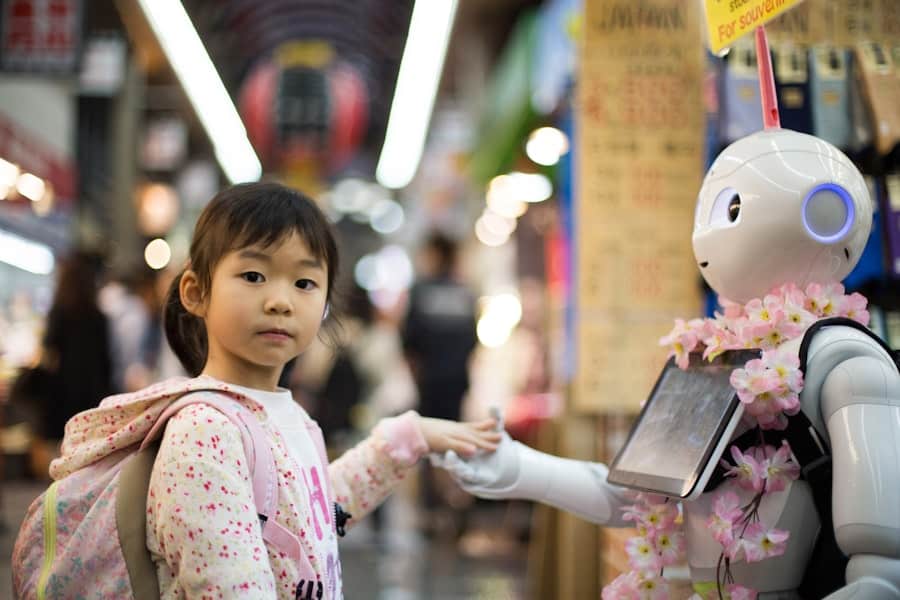The landscape of grocery shopping has undergone a significant transformation in recent years, driven by technological advancements and changing consumer preferences. On-demand grocery assistance has emerged as a pivotal solution, catering to the needs of busy individuals and families who seek convenience without compromising on quality.
The integration of technology into this process has not only streamlined operations but has also enhanced the overall shopping experience. As the demand for immediate gratification grows, so does the necessity for efficient systems that can handle the complexities of grocery logistics. Traditional grocery shopping, characterized by long lines and limited product availability, is increasingly being replaced by digital platforms that offer a wider selection and faster service.
This shift has paved the way for innovative solutions, including the use of robots, which are now playing a crucial role in fulfilling orders and managing inventory. The intersection of robotics and grocery assistance is not merely a trend; it represents a fundamental change in how consumers interact with food retail.
Key Takeaways
- On-demand grocery assistance is a growing trend in the retail industry, with the use of robots becoming increasingly popular for fulfilling customer orders.
- Robots are revolutionizing the grocery industry by streamlining operations, increasing efficiency, and improving customer satisfaction.
- The benefits of using robots for on-demand grocery assistance include faster order fulfillment, reduced labor costs, and improved accuracy in picking and packing items.
- Different types of robots, such as autonomous mobile robots and robotic arms, are being used to assist with on-demand grocery fulfillment, each with their own unique capabilities and functions.
- While robots offer numerous advantages, there are also challenges and limitations to consider, such as high initial investment costs, technical limitations, and potential job displacement.
The Rise of Robots in the Grocery Industry
The grocery industry has witnessed a remarkable rise in the adoption of robotics, driven by the need for efficiency and cost-effectiveness. Retailers are increasingly turning to automated systems to manage various aspects of their operations, from inventory management to order fulfillment. This shift is largely fueled by advancements in artificial intelligence (AI) and machine learning, which enable robots to perform complex tasks with precision and speed.
As a result, grocery stores are becoming more automated, allowing for quicker service and reduced labor costs. One notable example of this trend is the deployment of autonomous robots in warehouses and fulfillment centers. Companies like Ocado and Amazon have pioneered the use of robotic systems to pick and pack groceries efficiently.
These robots can navigate through aisles, identify products using advanced imaging technology, and even communicate with each other to optimize their routes. The success of these systems has prompted other retailers to explore similar technologies, leading to a broader acceptance of robots in the grocery sector.
Benefits of Using Robots for On-Demand Grocery Assistance

The integration of robots into on-demand grocery assistance offers numerous benefits that enhance both operational efficiency and customer satisfaction. One of the most significant advantages is the speed at which orders can be processed. Robots can work around the clock without fatigue, allowing for rapid order fulfillment that meets the growing consumer expectation for immediate delivery.
This capability is particularly valuable during peak shopping times or in response to sudden spikes in demand, such as during holidays or special promotions. Additionally, robots contribute to improved accuracy in order picking and inventory management. Human error is an inherent risk in manual processes, but robots equipped with sophisticated sensors and AI algorithms can significantly reduce mistakes.
This accuracy not only minimizes waste but also ensures that customers receive exactly what they ordered, enhancing their overall shopping experience. Furthermore, the use of robots can lead to cost savings for retailers, as they can operate with lower overhead costs compared to traditional labor models.
Types of Robots Used for On-Demand Grocery Assistance
Various types of robots are employed in the realm of on-demand grocery assistance, each designed to address specific tasks within the supply chain. One prominent category is autonomous mobile robots (AMRs), which are utilized for navigating warehouses and stores to transport goods. These robots are equipped with advanced navigation systems that allow them to move seamlessly through complex environments while avoiding obstacles.
For instance, companies like Walmart have implemented AMRs to assist with inventory checks and restocking shelves. Another type of robot gaining traction is the delivery robot, which operates outside the store environment. These small, wheeled robots are designed to transport groceries directly to customers’ homes.
They typically feature secure compartments for storing items and can navigate sidewalks and streets autonomously. Companies like Starship Technologies have successfully deployed these delivery robots in urban areas, providing a novel solution for last-mile delivery challenges.
Challenges and Limitations of Using Robots for On-Demand Grocery Assistance
Despite the numerous advantages associated with robotic systems in grocery assistance, several challenges and limitations persist. One significant hurdle is the initial investment required for implementing robotic technology. Retailers must weigh the costs of purchasing and maintaining robotic systems against potential savings in labor and operational efficiency.
For smaller businesses or those operating on thin margins, this investment may be prohibitive. Moreover, there are technical challenges related to the integration of robots into existing systems. Ensuring that robots can communicate effectively with inventory management software and other digital platforms is crucial for seamless operations.
Additionally, there are concerns regarding the reliability of robotic systems in unpredictable environments, such as busy grocery stores where human customers may inadvertently obstruct their paths or create hazards.
The Future of Robots in Providing On-Demand Grocery Assistance

Enhanced Capabilities through AI and Machine Learning
As technology continues to evolve, the future of robots in on-demand grocery assistance appears promising. Innovations in AI and machine learning will likely enhance the capabilities of robotic systems, enabling them to perform more complex tasks with greater efficiency. For instance, future robots may be able to analyze customer preferences and make personalized recommendations based on past purchases or dietary restrictions.
Expansion of Services and Personalized Experience
Furthermore, as consumer acceptance of robotic assistance grows, we may see an expansion in the types of services offered by these systems. For example, robots could be programmed to provide real-time updates on order status or even engage with customers through voice recognition technology.
A New Era of Interactive Shopping
This level of interaction could create a more personalized shopping experience that resonates with tech-savvy consumers.
Ethical and Social Implications of Using Robots for Grocery Assistance
The increasing reliance on robots for grocery assistance raises important ethical and social considerations that warrant careful examination. One primary concern revolves around job displacement; as automation becomes more prevalent, there is a legitimate fear that many retail workers may lose their jobs.
Additionally, there are questions about data privacy and security as robotic systems become more integrated into consumer interactions. Many robots collect data on customer preferences and behaviors, raising concerns about how this information is stored and used. Ensuring that consumer data is protected while still leveraging it for improved service will be a critical challenge for retailers moving forward.
The Impact of Robots on the On-Demand Grocery Industry
The impact of robots on the on-demand grocery industry is profound and multifaceted. As technology continues to advance, the role of robotics in grocery assistance will likely expand, offering new opportunities for efficiency and customer engagement. However, this transformation also necessitates a thoughtful approach to address ethical concerns and ensure that the benefits of automation are equitably distributed among all stakeholders involved in the grocery supply chain.
In summary, while robots present exciting possibilities for enhancing on-demand grocery services, it is essential to navigate the accompanying challenges with care. The future will require collaboration between technology developers, retailers, and consumers to create a grocery ecosystem that leverages automation while prioritizing human values and social responsibility.
In a related article discussing the best free software for 3D modeling in 2023, it highlights the advancements in technology that are shaping the future of various industries, including robotics. The Role of Robots in Providing On-Demand Grocery Assistance is just one example of how innovative software and hardware are being utilized to improve efficiency and convenience in our daily lives. To learn more about the latest tools and techniques in 3D modeling, check out this article.
FAQs
What is the role of robots in providing on-demand grocery assistance?
Robots play a crucial role in providing on-demand grocery assistance by automating tasks such as picking and packing items, restocking shelves, and even delivering groceries to customers’ homes.
How do robots assist in picking and packing items for on-demand grocery orders?
Robots are equipped with advanced sensors and grippers that enable them to identify and pick up specific items from shelves, and then pack them into bags or containers for delivery.
What are the benefits of using robots for on-demand grocery assistance?
Using robots for on-demand grocery assistance can lead to increased efficiency, reduced labor costs, improved accuracy in order fulfillment, and the ability to fulfill orders quickly, even during peak demand periods.
How do robots contribute to the restocking of shelves in grocery stores?
Robots can autonomously navigate through store aisles, identify low-stock items, and restock shelves with new inventory, helping to ensure that products are always available for customers.
Can robots be used for delivering groceries to customers’ homes?
Yes, robots equipped with autonomous navigation capabilities can be used to deliver groceries directly to customers’ homes, providing a convenient and contactless delivery option.

